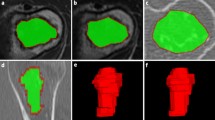Abstract
Objective
To assess the diagnostic performance of MRI-based texture analysis for differentiating enchondromas and chondrosarcomas, especially on fat-suppressed proton density (FS-PD) images.
Materials and methods
The whole tumor volumes of 23 chondrosarcomas and 24 enchondromas were manually segmented on both FS-PD and T1-weighted images. A total of 861 radiomic features were extracted. SelectKBest was used to select the features. The data were randomly split into training (n = 36) and test (n = 10) for T1-weighted and training (n = 37) and test (n = 10) for FS-PD datasets. Fivefold cross-validation was performed. Fifteen machine learning models were created using the training set. The best models for T1-weighted, FS-PD, and T1-weighted + FS-PD images were selected in terms of accuracy and area under the curve (AUC).
Results
There were 7 men and 16 women in the chondrosarcoma group (mean ± standard deviation age, 45.65 ± 11.24) and 7 men and 17 women in the enchondroma group (mean ± standard deviation age, 46.17 ± 11.79). Naive Bayes was the best model for accuracy and AUC for T1-weighted images (AUC = 0.76, accuracy = 80%, recall = 80%, precision = 80%, F1 score = 80%). The best model for FS-PD images was the K neighbors classifier for accuracy and AUC (AUC = 1.00, accuracy = 80%, recall = 80%, precision = 100%, F1 score = 89%). The best model for T1-weighted + FS-PD images was logistic regression for accuracy and AUC (AUC = 0.84, accuracy = 80%, recall = 60%, precision = 100%, F1 score = 75%).
Conclusion
MRI-based machine learning models have promising results in the discrimination of enchondroma and chondrosarcoma based on radiomic features obtained from both FS-PD and T1-weighted images.






Similar content being viewed by others
References
WHO Classification of Tumours Editorial Board eds. World Health Organization classification of soft tissue and bone tumours, 5th ed. Lyon: IARC Press, 2020.
Pan J, Zhang K, Le H, et al. Radiomics nomograms based on non-enhanced MRI and clinical risk factors for the differentiation of chondrosarcoma from enchondroma. J Magn Reson Imaging. 2021;54:1314–23. https://doi.org/10.1002/jmri.27690.
Gitto S, Cuocolo R, Emili I, et al. Effects of interobserver variability on 2D and 3D CT- and MRI-based texture feature reproducibility of cartilaginous bone tumors. J Digit Imaging. 2021;34:820–32. https://doi.org/10.1007/s10278-021-00498-3.
Lisson CS, Lisson CG, Flosdorf K, et al. Diagnostic value of MRI-based 3D texture analysis for tissue characterisation and discrimination of low-grade chondrosarcoma from enchondroma: a pilot study. Eur Radiol. 2018;28:468–77. https://doi.org/10.1007/s00330-017-5014-6.
Richter A, Sierocinski E, Singer S, et al. The effects of incidental findings from whole-body MRI on the frequency of biopsies and detected malignancies or benign conditions in a general population cohort study. Eur J Epidemiol. 2020;35:925–35. https://doi.org/10.1007/s10654-020-00679-4.
Deng XY, Chen HY, Yu JN, et al. Diagnostic value of CT- and MRI-based texture analysis and imaging findings for grading cartilaginous tumors in long bones. Front Oncol. 2021;11:700204. https://doi.org/10.3389/fonc.2021.700204.
Deckers C, Steyvers MJ, Hannink G, Schreuder HWB, de Rooy JWJ, Van Der Geest ICM. Can MRI differentiate between atypical cartilaginous tumors and high-grade chondrosarcoma? A systematic review Acta Orthop. 2020;91:471–8. https://doi.org/10.1080/17453674.2020.1763717.
Davnall F, Yip CS, Ljungqvist G, et al. Assessment of tumor heterogeneity: an emerging imaging tool for clinical practice? Insights Imaging. 2012;3:573–89. https://doi.org/10.1007/s13244-012-0196-6.
Lubner MG, Smith AD, Sandrasegaran K, Sahani DV, Pickhardt PJ. CT texture analysis: definitions, applications, biologic correlates, and challenges. Radiographics. 2017;37:1483–503. https://doi.org/10.1148/rg.2017170056.
Gitto S, Cuocolo R, van Langevelde K, et al. MRI radiomics-based machine learning classification of atypical cartilaginous tumour and grade II chondrosarcoma of long bones. EBioMedicine. 2022;75:103757. https://doi.org/10.1016/j.ebiom.2021.103757.
Gitto S, Cuocolo R, Albano D, et al. MRI radiomics-based machine-learning classification of bone chondrosarcoma. Eur J Radiol. 2020;128:109043. https://doi.org/10.1016/j.ejrad.2020.109043.
Fritz B, Müller DA, Sutter R, et al. Magnetic resonance imaging-based grading of cartilaginous bone tumors: added value of quantitative texture analysis. Invest Radiol. 2018;53:663–72. https://doi.org/10.1097/RLI.0000000000000486.
Douis H, Saifuddin A. The imaging of cartilaginous bone tumours. I Benign lesions Skeletal Radiol. 2012;41:1195–212. https://doi.org/10.1007/s00256-012-1427-0.
Murphey MD, Flemming DJ, Boyea SR, Bojescul JA, Sweet DE, Temple HT. Enchondroma versus chondrosarcoma in the appendicular skeleton: differentiating features. Radiographics. 1998;18:1213–37. https://doi.org/10.1148/radiographics.18.5.9747616.
Robinson P, White LM, Sundaram M, et al. Periosteal chondroid tumors: radiologic evaluation with pathologic correlation. AJR Am J Roentgenol. 2001;177:1183–8. https://doi.org/10.2214/ajr.177.5.1771183.
Tustison NJ, Avants BB, Cook PA, et al. N4ITK: improved N3 bias correction. IEEE Trans Med Imaging. 2010;29:1310–20. https://doi.org/10.1109/TMI.2010.2046908.
Collewet G, Strzelecki M, Mariette F. Influence of MRI acquisition protocols and image intensity normalization methods on texture classification. Magn Reson Imaging. 2004;22:81–91. https://doi.org/10.1016/j.mri.2003.09.001.
Koçak B, Durmaz EŞ, Ateş E, Kılıçkesmez Ö. Radiomics with artificial intelligence: a practical guide for beginners. Diagn Interv Radiol. 2019;25:485–95. https://doi.org/10.5152/dir.2019.19321.
Flemming DJ, Murphey MD. Enchondroma and chondrosarcoma. Semin Musculoskelet Radiol. 2000;4:59–71. https://doi.org/10.1055/s-2000-6855.
Skeletal Lesions Interobserver Correlation among Expert Diagnosticians (SLICED) Study Group. Reliability of histopathologic and radiologic grading of cartilaginous neoplasms in long bones. J Bone Joint Surg Am. 2007;89:2113–2123. https://doi.org/10.2106/JBJS.F.01530.
Author information
Authors and Affiliations
Corresponding author
Ethics declarations
Ethics approval
All procedures performed in studies involving human participants were in accordance with the ethical standards of the institutional and/or national research committee and with the 1964 Helsinki declaration and its later amendments or comparable ethical standards.
Conflict of interest
The authors of this manuscript declare no relationships with any companies, whose products or services may be related to the subject matter of the article.
Additional information
Publisher's note
Springer Nature remains neutral with regard to jurisdictional claims in published maps and institutional affiliations.
Rights and permissions
Springer Nature or its licensor (e.g. a society or other partner) holds exclusive rights to this article under a publishing agreement with the author(s) or other rightsholder(s); author self-archiving of the accepted manuscript version of this article is solely governed by the terms of such publishing agreement and applicable law.
About this article
Cite this article
Cilengir, A.H., Evrimler, S., Serel, T.A. et al. The diagnostic value of magnetic resonance imaging-based texture analysis in differentiating enchondroma and chondrosarcoma. Skeletal Radiol 52, 1039–1049 (2023). https://doi.org/10.1007/s00256-022-04242-y
Received:
Revised:
Accepted:
Published:
Issue Date:
DOI: https://doi.org/10.1007/s00256-022-04242-y




